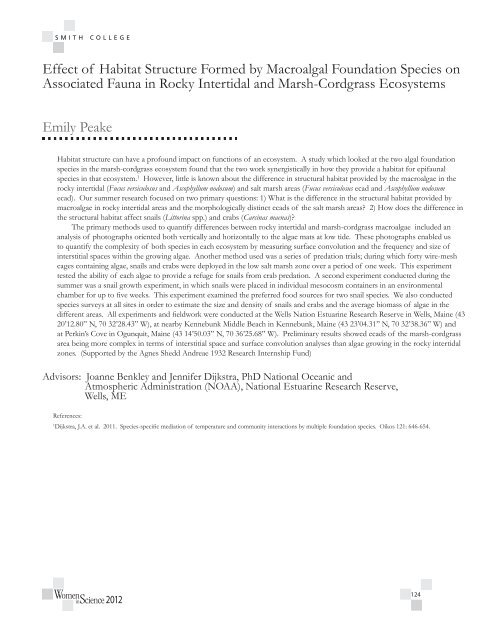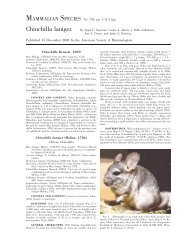Brugia Malayi - Clark Science Center - Smith College
Brugia Malayi - Clark Science Center - Smith College
Brugia Malayi - Clark Science Center - Smith College
Create successful ePaper yourself
Turn your PDF publications into a flip-book with our unique Google optimized e-Paper software.
Effect of Habitat Structure Formed by Macroalgal Foundation Species on<br />
Associated Fauna in Rocky Intertidal and Marsh-Cordgrass Ecosystems<br />
Emily Peake<br />
Habitat structure can have a profound impact on functions of an ecosystem. A study which looked at the two algal foundation<br />
species in the marsh-cordgrass ecosystem found that the two work synergistically in how they provide a habitat for epifaunal<br />
species in that ecosystem. 1 However, little is known about the difference in structural habitat provided by the macroalgae in the<br />
rocky intertidal (Fucus versiculosus and Ascophyllum nodosum) and salt marsh areas (Fucus versiculosus ecad and Ascophyllum nodosum<br />
ecad). Our summer research focused on two primary questions: 1) What is the difference in the structural habitat provided by<br />
macroalgae in rocky intertidal areas and the morphologically distinct ecads of the salt marsh areas? 2) How does the difference in<br />
the structural habitat affect snails (Littorina spp.) and crabs (Carcinas maenas)?<br />
The primary methods used to quantify differences between rocky intertidal and marsh-cordgrass macroalgae included an<br />
analysis of photographs oriented both vertically and horizontally to the algae mats at low tide. These photographs enabled us<br />
to quantify the complexity of both species in each ecosystem by measuring surface convolution and the frequency and size of<br />
interstitial spaces within the growing algae. Another method used was a series of predation trials; during which forty wire-mesh<br />
cages containing algae, snails and crabs were deployed in the low salt marsh zone over a period of one week. This experiment<br />
tested the ability of each algae to provide a refuge for snails from crab predation. A second experiment conducted during the<br />
summer was a snail growth experiment, in which snails were placed in individual mesocosm containers in an environmental<br />
chamber for up to five weeks. This experiment examined the preferred food sources for two snail species. We also conducted<br />
species surveys at all sites in order to estimate the size and density of snails and crabs and the average biomass of algae in the<br />
different areas. All experiments and fieldwork were conducted at the Wells Nation Estuarine Research Reserve in Wells, Maine (43<br />
20’12.80” N, 70 32’28.43” W), at nearby Kennebunk Middle Beach in Kennebunk, Maine (43 23’04.31’’ N, 70 32’38.36” W) and<br />
at Perkin’s Cove in Ogunquit, Maine (43 14’50.03” N, 70 36’25.68” W). Preliminary results showed ecads of the marsh-cordgrass<br />
area being more complex in terms of interstitial space and surface convolution analyses than algae growing in the rocky intertidal<br />
zones. (Supported by the Agnes Shedd Andreae 1932 Research Internship Fund)<br />
Advisors: Joanne Benkley and Jennifer Dijkstra, PhD National Oceanic and<br />
Atmospheric Administration (NOAA), National Estuarine Research Reserve,<br />
Wells, ME<br />
References:<br />
1<br />
Dijkstra, J.A. et al. 2011. Species-specific mediation of temperature and community interactions by multiple foundation species. Oikos 121: 646-654.<br />
2012<br />
124

















